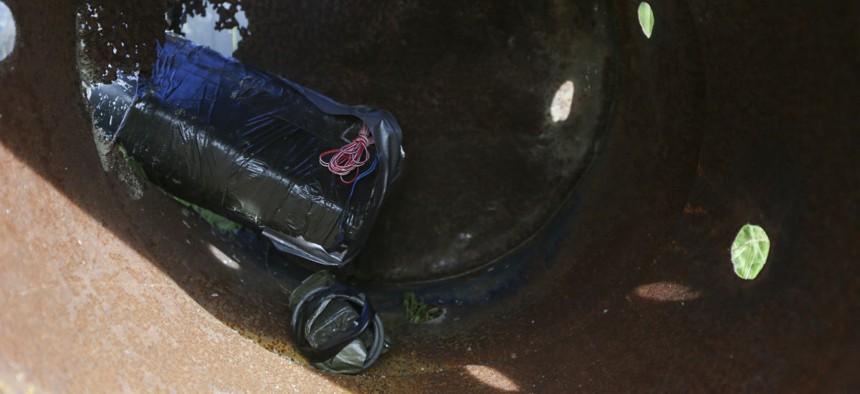NSA Dares College Students to Locate, Disarm Bombs Controlled through the Net

An improvised explosive device sits partially concealed in a barrel during counter-improvised explosive device skills demonstration training exercise at Camp Lejeune, N.C., Sept. 1. Lance Cpl. Aaron K. Fiala/Marine Corps
NSA officials say they will confront young computer scientists with the kinds of threats the agency faces daily, partly as an intelligence analyst recruitment effort.
At this moment, cybersecurity students are scouring networks for a secret computer program designed to trigger a (prop) roadside bomb, in a twist on the National Security Agency's annual coed codebreaking contest, according to NSA officials.
A few days ago, the agency provided college undergraduates and graduate students with file downloads for solving the Codebreaker Challenge, which, in this case, is to locate, replicate or "reverse engineer," and neutralize an improvised explosive device.
» Get the best federal technology news and ideas delivered right to your inbox. Sign up here.
According to a countdown clock on the competition website, you have 109 days left to deactivate the bomb:
DISCLAIMER: The following is a FICTITIOUS story meant for providing realistic context for the Codebreaker Challenge and is not tied in any way to actual events.
Terrorists have recently developed a new type of remotely controlled Improvised Explosive Device, making it harder for the U.S. Armed Forces to detect and ultimately prevent roadside bomb attacks against troops deployed overseas. The National Security Agency, in accordance with its support to military operations mission, has been asked to develop capabilities for use against this new threat. This will consist of six tasks of increasing difficulty, with the ultimate goals of being able to disarm the IEDs remotely and permanently render them inoperable without the risk of civilian casualties.
NSA officials say they will confront young computer scientists with the kinds of threats the agency faces daily, partly as an intelligence analyst recruitment effort.
"The challenge is designed to simulate aspects of NSA's mission," agency spokeswoman Clarese Wilson told Nextgov in an email.
New for 2016, the spy agency has added "network traffic analysis" to the specialties players will have to apply during the competition.
"Software reverse engineering and network analysis are two disciplines that are critical foundations of both NSA's defensive mission and its support to offensive missions carried out by the military," Wilson said.
The tasks range from identifying IED network ports to decrypting an IED key file to permanently disabling any IED, according to a competition FAQ.
A scoreboard on the contest site ranks participating students by tasks solved. So far, Georgia Tech is leading in three of the six tasks, with Carnegie Mellon University first in two activities. The most active players hail from Carnegie Mellon University Georgia Institute of Technology Dakota State University, University of Maryland, Baltimore County, North Carolina State and Johns Hopkins University.
Other resources available on the site include four online lectures about hacking techniques, including heap overflow and format string attacks.
Interested programmers must sign up through their school's .edu email accounts to compete and receive more information.
"The scenario will revolve around finding an improvised explosive device and having the students figure out how to reverse engineer and then disarm the IED," NSA officials said in a Sept. 12 announcement. "The 2016 scenario differs from previous challenges in that it provides insight into both offensive and defensive missions of the agency. Previous challenges had focused heavily on only the offensive mission."
During Operation Enduring Freedom, there have been more than 1,400 IED-related deaths since 2001, according to iCasualties.org. On Aug. 23, a U.S. service member was killed while conducting an operation with Afghan forces when their patrol triggered an IED, Military.com reports.
"Starting in 2005, we started seeing a big uptick in casualties caused by IEDs and ambushes," NSA Deputy Director Rick Ledgett told Fox News in May.
The agency then created a secretive program to deploy NSA specialists on the battlefield in order to send troops fresh intelligence so they could avoid ambushes. The program, called the Real Time Regional Gateway, created to combat the IED attacks “was really a complete change in how we provided signals intelligence support to the tactical warfighter," Ledgett told Fox.
For the first time, the student competition has added a beginner track so freshman with basic skills can compete.
As with last year's contest, NSA liaisons will be visiting some participating schools to help with the problem sets and detail job opportunities at the agency. There also we be a virtual tech talk hosted through Adobe Connect for students who have questions about the challenge.
"The challenge is entirely fictitious -- no actual military operations or use of the SIGINT system are involved in the challenge story or the files that the users download," Wilson said. "The challenge was developed entirely from scratch, but has been inspired by aspects of NSA's mission that are necessary to protect our nation."
NEXT STORY: Lawmakers: How Secure Are Voting Machines?






